Are you ready to transform your small space into a stylish haven? Get to read our guide on creative flooring design ideas tailored specifically for compact living areas.
We’ll explore how the right flooring patterns, colors, and materials can work wonders in maximizing space, enhancing aesthetics, and elevating the overall ambiance of your small room. Whether you’re dealing with a cozy studio apartment, a compact office nook, or a small bathroom, we’ve got you covered with inspiring tips and tricks to make your space feel larger, brighter, and more inviting. Let’s begin on creative flooring design ideas for small spaces.
Considerations for Flooring Design in Small Spall Spaces
Every square foot counts, making it crucial to optimize both aesthetics and functionality. By comprehensively assessing the layout, one can identify areas of high traffic, focal points, and potential obstacles. This understanding allows for strategic placement of flooring materials, ensuring durability in high-traffic zones and visual enhancement in focal areas.
For instance, in a small kitchen, spill-resistant and easy-to-clean materials like tile or vinyl may be preferable, while in a living room, cozy and visually appealing options like carpet or hardwood could be more suitable.
Understanding the layout enables seamless integration of the flooring design with the overall interior scheme. Harmonizing the flooring with other design elements such as furniture, wall colors, and decor creates a cohesive and visually pleasing space
Choosing the Right Flooring Material
When it comes to flooring materials for small spaces, there are several factors to consider, including durability, aesthetics, maintenance, and how the material interacts with the limited space available. Let’s delve into a comparison of various flooring materials and their suitability for small spaces:
Hardwood
Hardwood flooring is a classic choice known for its timeless appeal and natural warmth. In small spaces, hardwood can create a sense of continuity, making the area feel more expansive.
Its versatility allows it to complement a wide range of interior styles, from traditional to contemporary. However, hardwood may not be the most practical option for high-moisture areas like bathrooms or kitchens unless properly sealed.
Hardwood also requires regular maintenance to preserve its beauty and integrity, including refinishing every few years to address wear and tear.
Laminate
Laminate flooring offers a budget-friendly alternative to hardwood, mimicking its appearance while providing greater durability and resistance to moisture and scratches. This makes laminate an excellent choice for small spaces prone to heavy foot traffic or spills, such as entryways or living rooms.
Its easy installation process and low maintenance requirements make it appealing for homeowners seeking a hassle-free flooring solution. However, laminate may lack the authenticity and warmth of real hardwood, which could impact the overall ambiance of the space.
Vinyl
Vinyl flooring has undergone significant advancements in recent years, emerging as a highly versatile and cost-effective option for small spaces. Available in a wide range of designs, including wood, stone, and tile patterns, vinyl offers endless possibilities for customization.
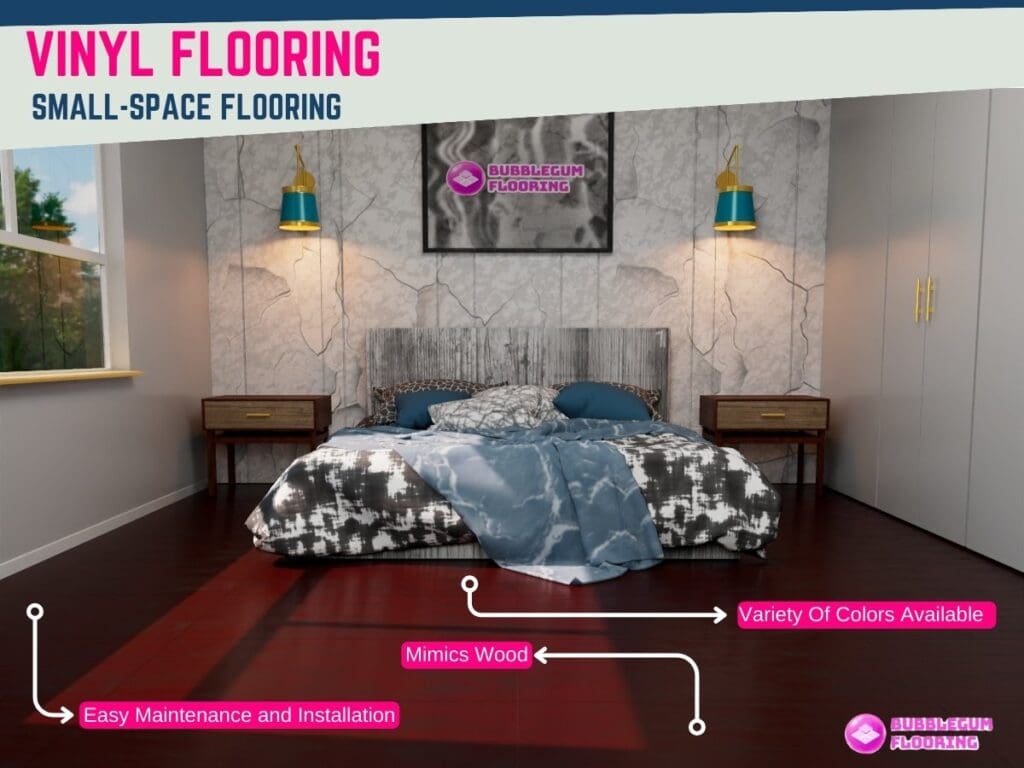
Its water-resistant properties make it ideal for kitchens, bathrooms, and laundry rooms, where spills are common.
Vinyl is relatively low-maintenance, requiring only regular sweeping and occasional mopping to keep it looking its best. However, some may find that vinyl lacks the luxurious feel of natural materials like hardwood or stone.
Porcelain Tile
Porcelain tile is prized for its durability, making it a popular choice for high-traffic areas in small spaces, such as kitchens and bathrooms. Its resistance to moisture, stains, and scratches ensures longevity, making it a worthwhile investment for homeowners seeking a long-term flooring solution.
Porcelain tile is available in a wide array of colors, patterns, and finishes, allowing for creative expression and customization to suit any design aesthetic. While porcelain tile can be more expensive than other flooring options, its durability and aesthetic appeal make it a preferred choice for small spaces where durability is paramount.
Carpet Tiles
Carpet tiles offer a versatile and customizable flooring solution for small spaces, allowing for easy installation and replacement. Their modular nature allows homeowners to mix and match colors and patterns to create unique designs while providing the comfort and warmth of traditional carpet.
Carpet tiles are particularly well-suited for bedrooms, home offices, or playrooms, where added insulation and noise reduction are desired. However, in high-traffic areas, carpet tiles may show signs of wear more quickly than other flooring materials, requiring periodic replacement to maintain a fresh appearance.
Creative Flooring Patterns for Small Spaces
In small spaces, the right flooring pattern can make a significant difference, visually expanding the area and enhancing its aesthetic appeal. Here are several creative flooring patterns tailored for small spaces:
Diagonal Lines
One of the most effective ways to create the illusion of space in a small room is by installing flooring with diagonal lines. Diagonal patterns draw the eye outward, making the room appear larger and more open. This technique works well with various flooring materials, including hardwood, laminate, tile, and vinyl.
Whether using planks, tiles, or strips, laying them diagonally across the room creates a dynamic visual effect that can transform the perception of space. Diagonal lines can also add a sense of movement and energy to the room, enhancing its overall ambiance.
Chevron or Herringbone
Chevron and herringbone patterns offer a sophisticated and visually appealing flooring option for small spaces. By arranging planks or tiles in a V-shaped or zigzag pattern, these designs add depth and dimension to the room, making it feel more expansive.
Chevron patterns feature continuous zigzag lines, while herringbone patterns consist of staggered rectangular pieces arranged in a V-shaped pattern. Both patterns create a sense of movement and flow, making them ideal for small spaces where maximizing visual impact is essential.
Large Format Tiles
Opting for large format tiles can also create the illusion of space in a small room. Larger tiles minimize grout lines, creating a seamless look that visually expands the floor area. This design strategy works particularly well in bathrooms and kitchens, where fewer grout lines mean easier maintenance and a cleaner appearance.
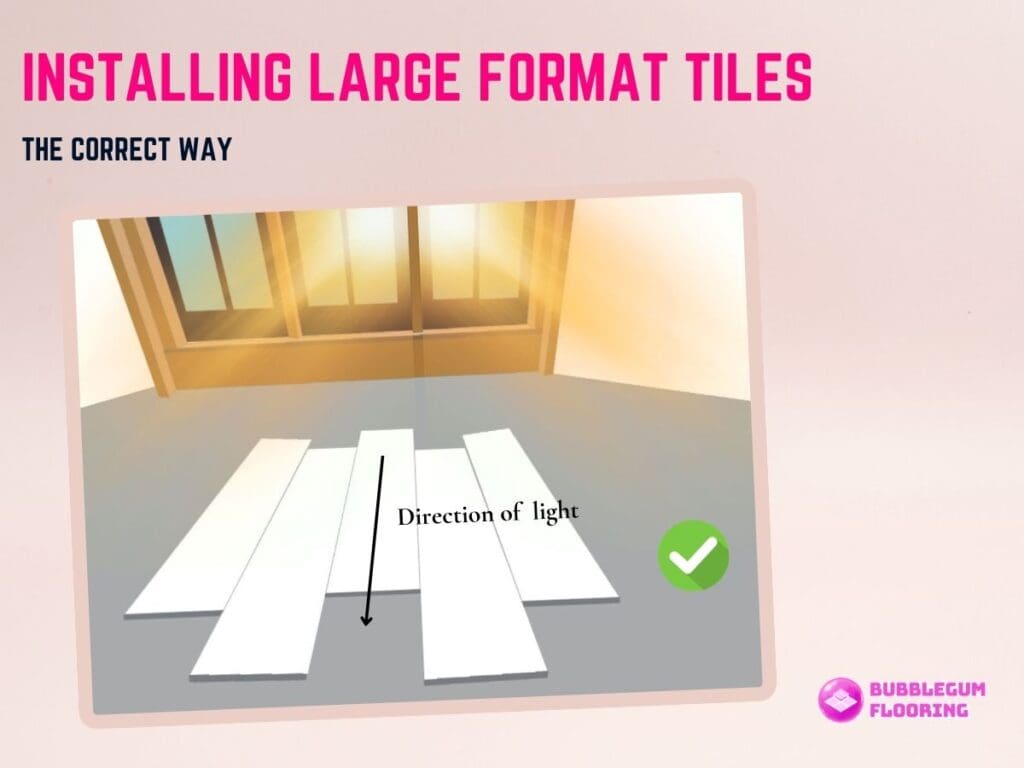
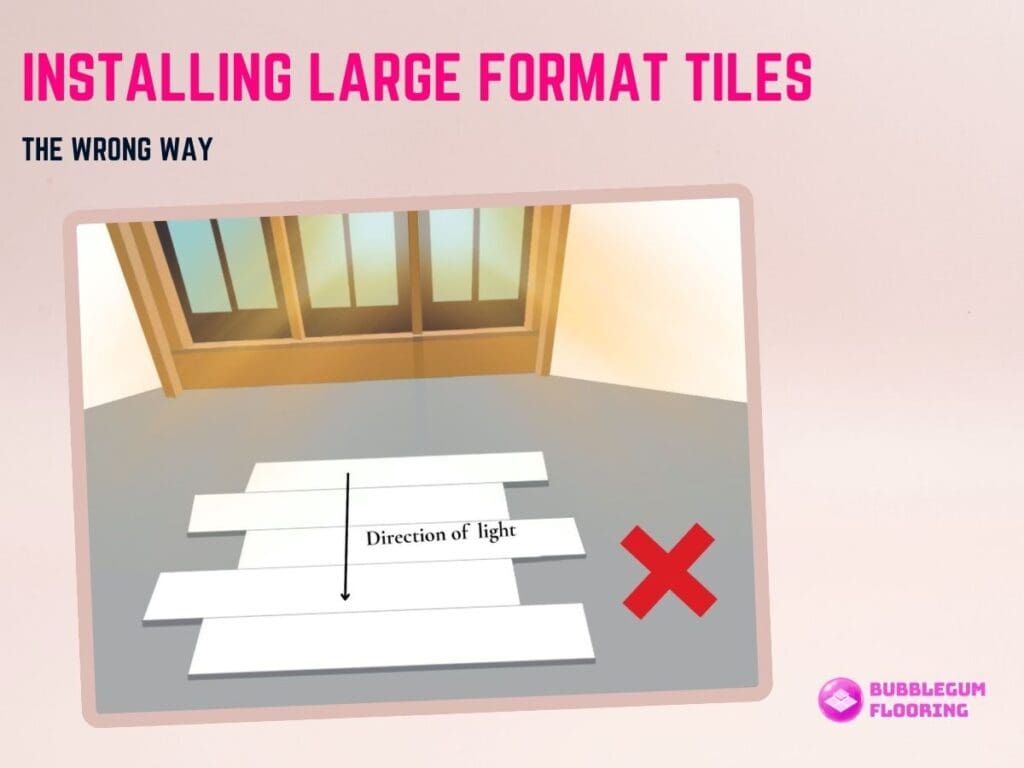
Large format tiles come in various materials, including porcelain, ceramic, and natural stone, offering versatility in design and style. Using the same large format tiles on both the floor and walls can further enhance the sense of continuity and spaciousness in the room.
Mixed Materials
Combining different flooring materials in a small space can add visual interest and personality while maximizing functionality. For example, using hardwood or laminate in the main living area and transitioning to tile or vinyl in high-moisture areas like the kitchen or bathroom creates a seamless flow while addressing practical concerns.
Similarly, incorporating contrasting materials or colors in adjacent rooms or zones can delineate separate areas within the small space, creating a sense of depth and dimension. Mixing materials allows homeowners to customize their flooring design to suit their lifestyle and aesthetic preferences while optimizing the use of space.
Geometric Patterns
Geometric patterns offer a modern and playful flooring option for small spaces, adding visual intrigue and personality to the room. Whether using hexagonal tiles, diamond shapes, or intricate mosaic patterns, geometric designs can make a bold statement while creating a sense of movement and rhythm.
These patterns work well in various spaces, from entryways and bathrooms to kitchens and living rooms, adding a touch of contemporary flair to the interior. Geometric patterns can also be customized to suit any color scheme or design theme, allowing for endless possibilities for creative expression
Using Color to Enhance Small Spaces
The choice of flooring color can significantly influence the perceived size and feel of a small space, with light and dark colors each offering distinct advantages and effects.
Light Colors
Light-colored flooring, such as soft whites, creams, light grays, or natural wood tones, can create a sense of spaciousness and airiness in a small room. Light hues reflect more natural light, helping to brighten the space and make it feel more open and inviting.
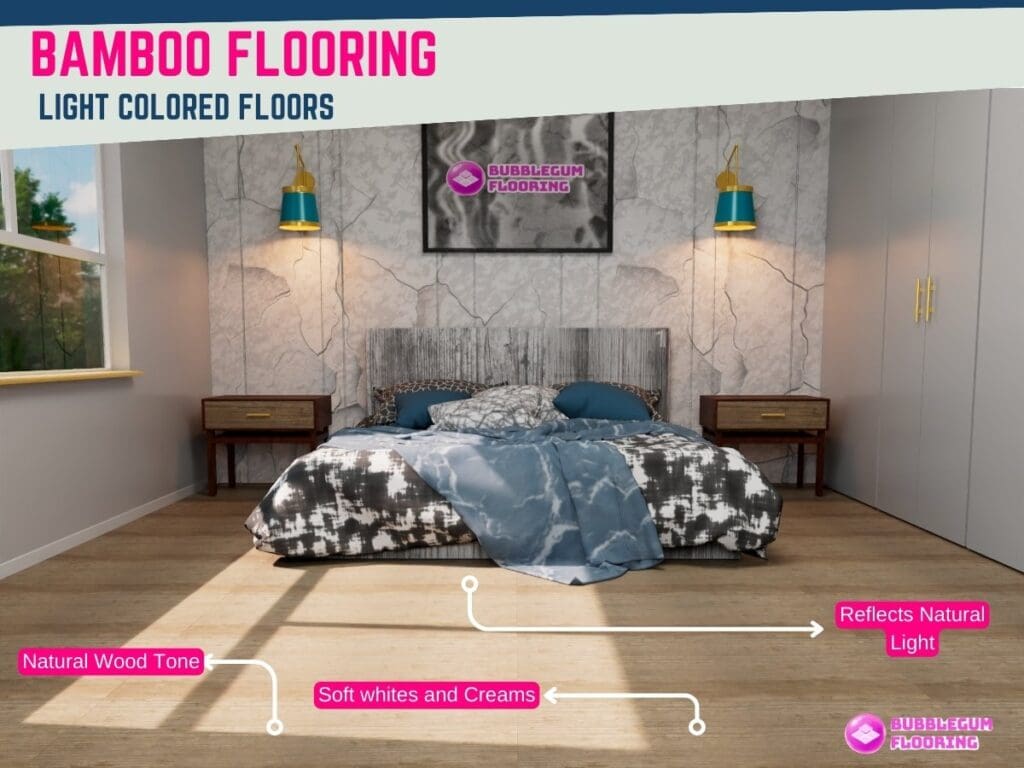
In rooms with limited natural light, such as basements or north-facing spaces, light-colored flooring can help maximize the available light, creating a warmer and more welcoming atmosphere.
Light-colored floors are also versatile and can complement a wide range of interior styles, from modern and minimalist to rustic and Scandinavian.
Dark Colors
Dark-colored flooring, including deep browns, charcoal grays, or rich ebony tones, can add depth and drama to a small space. While dark floors absorb more light, they can create a cozy and intimate ambiance, especially in larger rooms where the aim is to create a sense of warmth and sophistication.
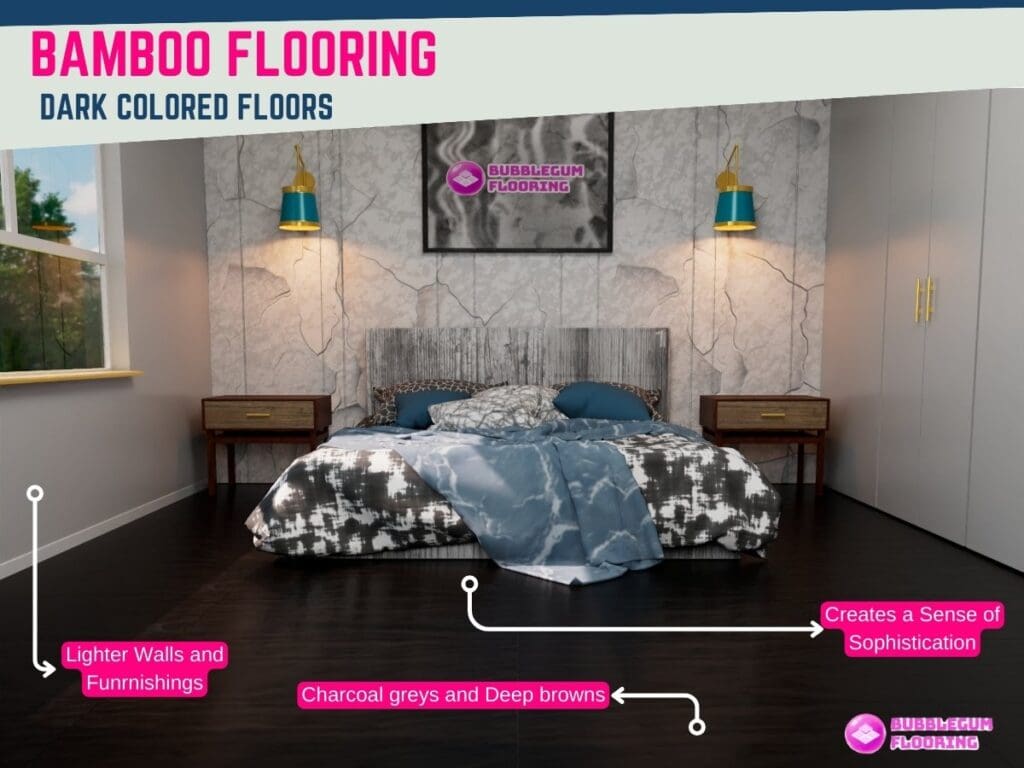
In small spaces, dark floors can visually ground the room and create a sense of balance, particularly when paired with lighter walls and furnishings. Dark flooring can conceal dirt and stains more effectively than lighter options, making it a practical choice for high-traffic areas or homes with pets and children.
Maximizing Natural Light with Reflective Flooring Materials
Natural light can significantly enhance the ambiance and perceived spaciousness of a small space. By strategically choosing flooring materials with reflective properties, homeowners can amplify the effects of natural light, creating a brighter and more inviting environment. Here’s how flooring design can help maximize natural light in a small space:
- Use of Glossy Finishes: Opt for flooring materials with glossy or polished finishes, such as polished concrete, high-gloss laminate, or glazed ceramic tiles. These surfaces reflect light more effectively than matte finishes, helping to distribute light evenly throughout the room.
- Light-Colored Options: Choose light-colored flooring options, such as white or light gray, to further enhance the reflective properties. Light hues not only brighten the space but also create a sense of openness by bouncing light off the floor surface.
- Mirrored Surfaces: Consider incorporating mirrored elements into the flooring design, such as mirrored tiles or mosaic patterns. Mirrored surfaces reflect light from windows and fixtures, amplifying natural light and creating a luminous effect in the room.
- Floor-to-Ceiling Windows: Align the flooring design with floor-to-ceiling windows or glass doors to maximize the impact of natural light. Reflective flooring materials near these openings can help bounce light deeper into the room, reducing the need for artificial lighting during the day.
- Strategic Placement of Light Fixtures: Coordinate the placement of light fixtures with reflective flooring materials to optimize natural light distribution. Positioning lamps or overhead lights near reflective surfaces can further amplify the brightness of the space.
- Minimalist Approach to Furnishings: Adopt a minimalist approach to furnishings to allow natural light to bounce freely around the room. Avoid blocking windows or glass doors with bulky furniture pieces, and opt for light-colored or transparent furniture to maintain an airy feel.
- Regular Maintenance: Keep reflective flooring materials clean and free of debris to ensure maximum light reflection. Regular sweeping, mopping, and polishing will help maintain the glossy finish and enhance the reflective properties of the flooring.
Conclusion
Creative flooring design ideas hold immense potential in elevating the aesthetic and practical aspects of small spaces. By incorporating innovative patterns, colors, and materials, homeowners can create visually stunning environments that maximize the available space while enhancing functionality and comfort.
Whether aiming to create a sense of openness with light-colored floors or add depth and character with geometric patterns, the possibilities are endless. With thoughtful planning and design, small spaces can be transformed into captivating retreats that inspire and delight occupants for years to come.


